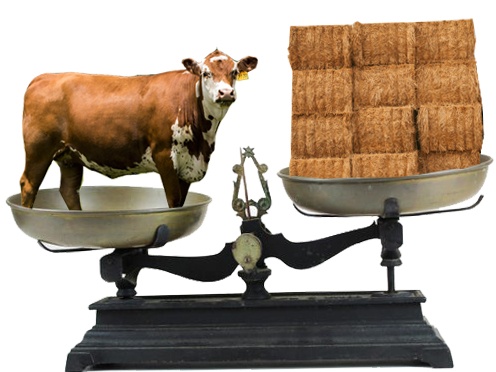 This time of year, especially after you have shifted from grazing to fed feed such as hay or baleage, you might start wondering why you have the number of livestock you have. Life is short, and some animals just need to grow some wheels. It’s probably a good thing to question the number of grazing livestock you have, especially when you are feeding them stored and/or bought feed. I said it recently, but I’ll quote the late Gearld Fry again:
This time of year, especially after you have shifted from grazing to fed feed such as hay or baleage, you might start wondering why you have the number of livestock you have. Life is short, and some animals just need to grow some wheels. It’s probably a good thing to question the number of grazing livestock you have, especially when you are feeding them stored and/or bought feed. I said it recently, but I’ll quote the late Gearld Fry again:
“If you cull the ten percent you should be culling, the herd that’s left is just that much better.”
I was at a meeting recently and was asked a familiar question about how many acres you need to have per cow. That is a question that can’t be answered quickly, at least not accurately. What does the question on “acres per cow” have to do with winter feeding? It’s important if you care about cow cost and inputs. Winter feed costs usually make up the majority of annual maintenance expenses of keeping a cow. If you have enough forage available, you have potential to graze more days and the more grazing time you have for the cows, or whatever grazing livestock you have, the less fed feed you will need.

Let’s Break This Down
There are several variables to this “acres per cow” question. Let’s first look at the dry matter requirements of a cow for a year. To keep the math easy and to also mimic a common unit, let’s use a 1,000-pound cow or one animal unit (AU) which is one thousand pounds live weight. If that cow had weighed 1,200 pounds, she would be 1.2 AU’s.

How much will this 1,000-pound cow eat in a year? The factors that influence the amount a cow will eat include her weight, body condition, and stage of pregnancy or lactation. Forage quality is also important. What she eats must meet her needs or she will lose weight. In this case, to make our figuring easier, we’ll assume that our forage is good quality and meets her needs. This means that in most cases, the average maintenance intake is about 2.6% of the body weight up to about 3.5% at peak lactation or slightly higher for a first calf heifer. A safe average number to use is generally 3%. So, that 1,000-pound (1 AU) cow will consume on average thirty pounds of dry matter per day. Her average yearly dry matter intake will then be 10,950 pounds.
Let’s pause and think about this for a moment. To feed this one, 1,000-pound cow for a year, without any waste considered or harvest efficiency figured, she’s going to need to consume 5.5 tons of dry matter from pasture or fed feed. Let’s first look at what this would look like as dry hay. That 5.5 tons in 1,500-pound round bales (not corrected for moisture) is equivalent to approximately 7.3 round bales or about 180 small square bales.

When you harvest hay off a field, the average harvest efficiency is about 70%. The remaining is stubble left after mowing and lost, missed, or dropped leaves. At 70% harvest efficiency, the amount of gross dry matter produced to make the 10,950 pounds of dry matter harvested is actually 15,643 pounds.
If you kept the cow in a pen and carried everything to her, then we have to also consider feeding efficiency and possibly storage loss. Sadly, hay stored outside, on the ground, and fed directly, can have high wastage. We can have similar wastage when they are grazing. Some of the wastage easily seen comes from forage that is tainted by an animal’s manure, urine, or to a degree, perhaps smelly feet of another cow.

Let’s now look at it from the other side of the fence. How many acres would it take to produce eight tons of total forage? There are always exceptions, but a high average for our area probably wouldn’t make four tons per acre. If it did, that means it will take two acres of forage with a harvest efficiency of 70% (equivalent to daily moves) to meet the dry matter needs of that one 1,000-pound cow for a year. If the average yield is only three tons per acre, then 2.6 acres of forage would be required. Certainly, some highly managed hay fields can exceed the four-ton yield, but those are not average.
So far, we’ve looked at this purely as if it is a closed system. In other words, you are not bringing any dry matter onto the farm, you are basing it only off what is produced there. Just so we’re on the same page, you are also assuming that this dry matter is either forage grazed or harvested and fed on the farm.
Your Grazing Management Matters
If you allow overgrazing of the forage where those stop grazing heights are not maintained, you will not maintain a sufficient solar panel or plant energy reserve, and this will mean a loss in potential production. The same thing happens if you delay grazing too long; quality is reduced and so is some regrowth potential. How the forage is managed (i.e. residual or stop grazing heights maintained, rest allowed for regrowth and refreshing energy reserves, start grazing heights), and how it is allocated, highly influences the grazing efficiency of the system. You can quickly go from 70% efficiency to thirty-something as management or sometimes conditions decrease.

I often question grazing efficiencies and find myself testing them. It’s not an easy task. Even if you take away all grazing factors such as caging an area for a season so you can take a clipping off that caged area to figure season long production, it can still be off some due to loss of potential regrowth between timely grazing events. If forages can be maintained more, in what I often call phase two, where the solar panel is the most active due to the highest leaf area being available and before flowering, then we can potentially increase production because we are able to collect more solar energy for a longer period of time and take advantage of more tillering and regrowth, as long as fertility and moisture are not limited.
On average, continuous grazing often has a grazing efficiency of about 30% to 50% due to suppressed growth and regrowth, avoided areas that can come from underutilized areas and undesirable species, and stocking rate. Under high management, frequent moves and appropriate allocations, you can often be equivalent to hay harvest efficiency or slightly higher. With a good system at top efficiency, and average production of three tons per acre, you’ll need 2.6 acres to meet the dry matter requirements of the 1,000-pound cow for a year.
If you are continuously grazing, you will need more acres. What? That sounds crazy, but lost production is normally replaced with supplemental hay or feed outside the system and you don’t realize how out of balance things really are. Sometimes letting a few animals go, especially when quite a bit of supplemental hay or feed is needed to sustain those numbers, ends up being better on the bottom line.
Keep on grazing!
Want More?
Krista Ehlert helps you with the math to figure your own stocking rate.





I live in Nicaragua. The climate is. Similar to Florida, which type of grass woul you recommend f or that region? And wher can I. Purchase it?
Comments are closed.